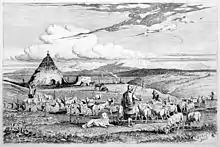Charles Coleman | |
|---|---|
 Charles Coleman, etching of transhumant shepherds in the Campagna Romana, showing sheep, a working dog of Pastore Maremmano-Abruzzese type, horses of Maremmano type and a conical capanna or lestra; from A Series of Subjects peculiar to the Campagna of Rome and Pontine Marshes (1850) | |
| Born | Charles Coleman c. 1807 Pontefract, Yorkshire |
| Died | 1874 Rome |
| Nationality | British |
| Known for | |
| Movement | Campagna Romana School |
| Spouse | Fortunata Segadori |
Charles Coleman (c. 1807 – 1874) was a British landscape and animal painter, born in Pontefract, in Yorkshire, England. He was active principally in Rome, where was an important influence on Nino Costa and made a significant contribution to the formation of the Campagna Romana School of painting.
Life
Coleman first went to Rome in 1831 to study the paintings of Michelangelo and Raphael.[1]: 14 [2] He became permanently resident there in 1835,[3] and on 21 June 1836 married Fortunata Segadori (or Segatori) from Subiaco, who, along with Vittoria Caldoni of Albano, was one of the most famous Roman models of the time.[4]: 247 Segadori had sat for August Riedel;[5]: 490 a portrait of her by Johann Heinrich Richter is in the Thorvaldsen Museum in Copenhagen. The couple had eight children; their son Enrico Coleman (1846–1911), was also a landscape painter, in oils and watercolour, as was the younger and less well-known Francesco Coleman. The Colemans' first address was 25 via Zucchelli.[4]: 247 In 1869 the family moved to 16 via Zucchelli, and for the first time Coleman set up a separate studio, at 33 via Margutta, possibly with the intention of providing space for his two painter sons.[3][4]: 247
Works
Four of his paintings, dated from 1845 to 1847 and all featuring buffaloes, are listed in the catalogue of the collection of Beriah Botfield.[6]: 11 From 1848 to 1850 he made etchings of scenes and animals in the Campagna Romana, and these were published in 1850 as A Series of Subjects peculiar to the Campagna of Rome and Pontine Marshes, designed from nature and etched by C. Coleman.[7] He was dismissive of academic teaching, believing that observation from nature was the best education for an artist.[8]: 88 He exhibited five times at the Royal Academy of London, for the last time in 1869.[4]: 247
Coleman remained largely unknown in his native country but became a major influence on the Italian landscape painter Nino Costa, whom he met in the Campagna in the early 1850s.[9]: 56 Coleman was considered the founder of the "Campagna Romana" school of painting in Italy.[8]: 88
He died in Rome in 1874.[10]
Published works
- A Series of Subjects peculiar to the Campagna of Rome and Pontine Marshes, designed from nature and etched by C. Coleman Rome: [s.n.] 1850.
References
- ↑ Riccardo Quintieri (1901). La Rassegna internazionale della letteratura e dell'arte contemporanea, volumes 6–7 (in Italian). Firenze: Libreria Fratelli Bocca.
- ↑ Claudia Tempesta (1982). Coleman, Enrico (in Italian). Dizionario Biografico degli Italiani, volume 26. Roma: Istituto dell'Enciclopedia Italiana. Accessed August 2021.
- 1 2 Carlo Sisi (2003). La pittura di paesaggio in Italia: L'Ottocento (in Italian). Milano: Electa. ISBN 9788843557462.
- 1 2 3 4 Pier Andrea De Rosa, Paolo Emilio Trastulli (2001). La campagna romana da Hackert a Balla (in Italian). Rome: Studio Ottocento for Museo del Corso. ISBN 9788880164784.
- ↑ Francesco Protonotari (editor) (1907). Nuova antologia, volume 214 (in Italian). Roma: Nuova Antologia.
- ↑ Beriah Botfield (1848). Catalogue of pictures in the possession of Beriah Botfield, Esq., at Norton Hall. London: [William Nicols].
- ↑ Charles Coleman (1850). A Series of Subjects peculiar to the Campagna of Rome and Pontine Marshes, designed from nature and etched by C. Coleman Rome: [s.n.].
- 1 2 Giuliana Pieri (2007). The Influence of pre-Raphaelitism on Fin de Siècle Italy. London: Maney Publications for the Modern Humanities Research Association. ISBN 9781904350446.
- ↑ Olivia Rossetti Agresti (1907). Giovanni Costa, his life, work, and times, second edition. London: Gay & Bird. (first edition: London: Grant Richards, 1904)
- ↑ Enrico Coleman (in Italian). Enciclopedie on line. Roma: Istituto dell'Enciclopedia Italiana. Accessed August 2021.